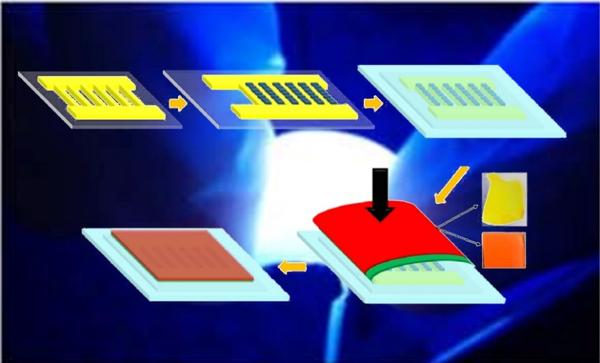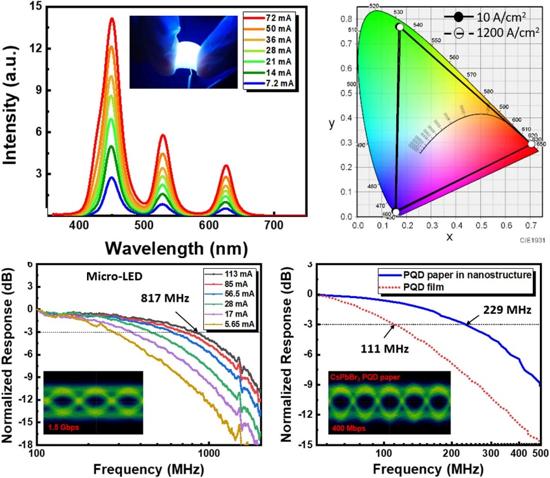Through technological advances, light-emitting diode (LED)-based systems have been commercialized and are now widely used in applications such as large displays, traffic lights, indoor and street lighting, automobiles, cell phones, and liquid-crystal displays.
Recently, white-light-emitting materials have attracted considerable attention owing to their potential use in LEDs, lighting, communications, and, especially, flexible display devices. White-light systems based on micro-LEDs and color converters such as quantum dots (QDs) are becoming more prominent in visible-light communication (VLC) applications.
For WLEDs, the fluorescence lifetimes of the color-conversion materials have a more significant influence on the resultant VLC. Halide perovskite QDs (PQDs) have evolved as an alternative to conventional QDs because of their outstanding characteristics, which derive from their narrower half width (below 30 nm), greater color purity, and higher photoluminescence quantum yield (approaching 100%).
In particular, PQDs exhibiting short carrier recombination lifetimes and narrow spectral linewidths have attracted interest because they can be used to develop white-light VLC systems with considerably higher modulation bandwidth than CdSe/ZnS QDs. To date, no PQDs with modulation bandwidths exceeding 200 MHz have been developed; therefore, development of a high-performance VLC system combining high-bandwidth micro-LEDs with high-bandwidth PQDs is necessary.
Recently, a research team led by Professor Kuo Hao-Chung from Taiwan Yang Ming Chiao Tung University and Associate Professor Tingzhu Wu from Xiamen University jointly propose a high-performance white light system with huge potential for VLC applications.
The system consists of semi-polar blue micro-LED, nano-structured green light-emitting CsPbBr3 quantum dot paper, and red light-emitting CdSe quantum dot paper (as shown in Fig.1). The research results are now published in Photonics Research, Vol 9, No. 12, 2021 (Konthoujam James Singh, Xiaotong Fan, Annada Sankar Sadhu, et al. CsPbBr3 perovskite quantum-dot paper exhibiting a highest 3 dB bandwidth and realizing a flexible white-light system for visible-light communication[J]. Photonics Research, 2021, 9(12): 12002341).

Fig.1. Flexible white-light VLC system with a wide color gamut and high modulation bandwidth.
As shown in Fig.2, the white-emission is achieved by blue micro-LED and green/red QDs papers, and the emission wavelengths have negligible shift with increasing drive current. according to the Commission Internationale de L'Eclairage (CIE) 1931 color space. The white-light system demonstrated a wide color gamut owing to the narrow EL spectrum, achieving 98.7% of the National Television Standards Committee (NTSC) space and 91.1% Rec. 2020 of the CIE 1931 color space.

Fig. 2. Performance of color gamut and bandwidth of the flexible white-light VLC system.
The VLC properties are also illustrated in Fig.2. The semipolar micro-LED has a maximum bandwidth of 817 MHz and a peak emission wavelength of 441 nm. The maximum bandwidth of the green quantum dot paper is 229 MHz, which is one of the highest bandwidth reported so far, while the observation bandwidth of the red CdSe quantum dot paper is less than 25 MHz. The data rates of semi-polar micro-LED and green quantum dot paper are 1.5 Gbps and 400 Mbps, respectively. The final packaged flexible white light system based on quantum dots can also achieve a maximum 3 dB bandwidth of 95.5 MHz. The results show that the white light system has broad prospects in VLC applications.
The first author is Konthoujam James Singh from Taiwan Yang Ming Chiao Tung University, the corresponding authors are Kuo Hao-Chung from Taiwan Yang Ming Chiao Tung University and Wu Tingzhu from Xiamen University. The authors thank the funding of Ministry of Science and Technology, Taiwan, China (108-2221-E-009-113-MY3, 110-2124-M-A49-003-), National Natural Science Foundation of China (11904302), Major Science and Technology Project of Xiamen, China (3502Z20191015).


